Accounting and Finance: Analyzing ABC Costing for UAE Trekker LLC
VerifiedAdded on 2023/01/12
|9
|2263
|23
Report
AI Summary
This report presents an analysis of the implementation of Activity-Based Costing (ABC) in the context of UAE Trekker LLC, a company producing hiking backpacks. The report begins with calculations of cost per unit under both full absorption costing and ABC, highlighting the differences and the reasons behind them. It explains how the switch from traditional absorption costing to ABC impacts cost allocation, emphasizing the use of multiple cost drivers in ABC. The report then discusses the implications of switching to ABC for cost management, emphasizing its accuracy and reliability in determining product costs, especially in technology-driven environments. The impact of ABC on product profitability and pricing is explored, along with steps and pitfalls to consider when introducing an ABC system. The analysis also provides insights into the benefits of ABC in enhancing profitability through accurate pricing and streamlined business processes. The report concludes by summarizing the advantages of ABC over traditional costing methods.

Accounting and Finance for
Decision Making
Decision Making
Paraphrase This Document
Need a fresh take? Get an instant paraphrase of this document with our AI Paraphraser

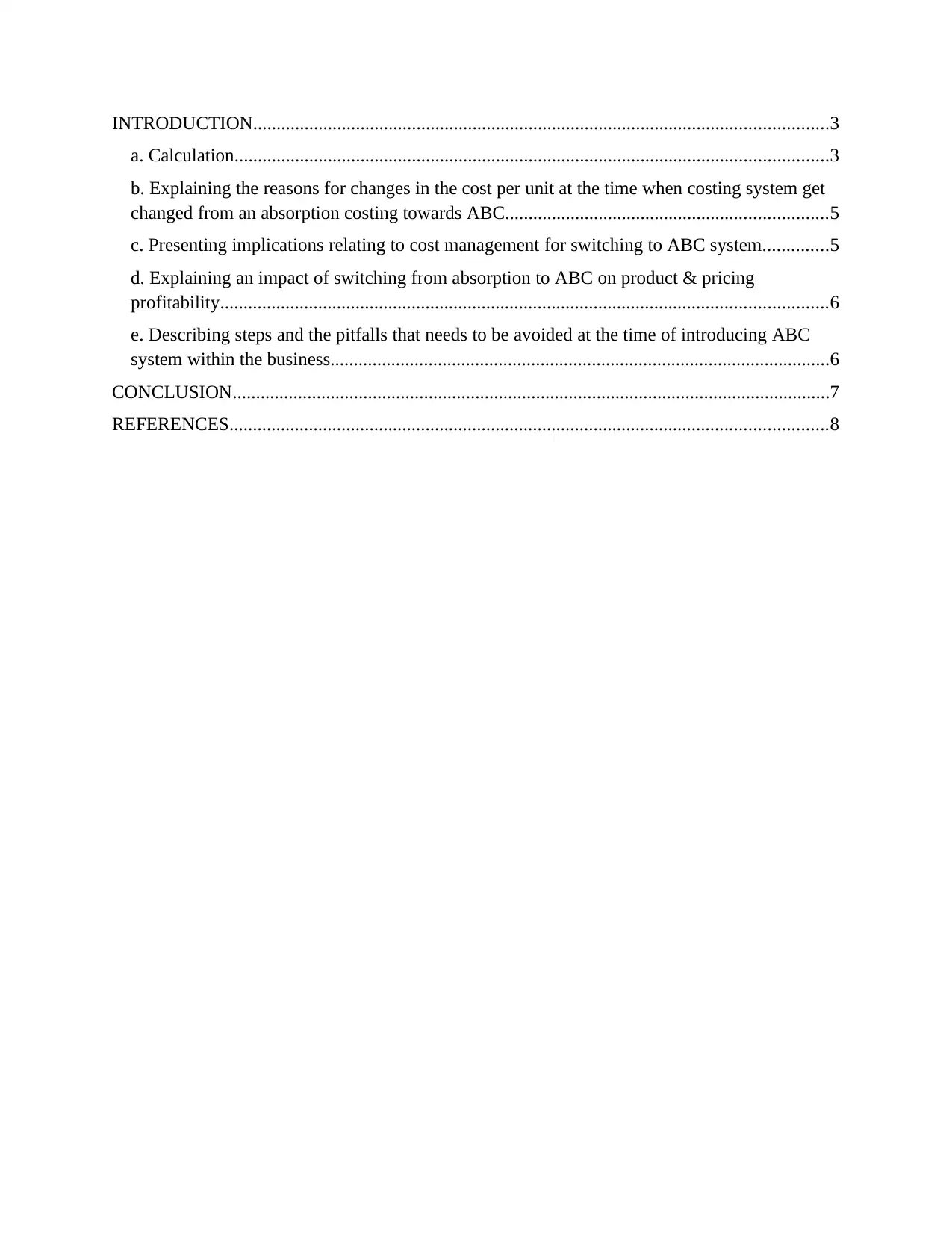
INTRODUCTION...........................................................................................................................3
a. Calculation...............................................................................................................................3
b. Explaining the reasons for changes in the cost per unit at the time when costing system get
changed from an absorption costing towards ABC.....................................................................5
c. Presenting implications relating to cost management for switching to ABC system..............5
d. Explaining an impact of switching from absorption to ABC on product & pricing
profitability..................................................................................................................................6
e. Describing steps and the pitfalls that needs to be avoided at the time of introducing ABC
system within the business...........................................................................................................6
CONCLUSION................................................................................................................................7
REFERENCES................................................................................................................................8
a. Calculation...............................................................................................................................3
b. Explaining the reasons for changes in the cost per unit at the time when costing system get
changed from an absorption costing towards ABC.....................................................................5
c. Presenting implications relating to cost management for switching to ABC system..............5
d. Explaining an impact of switching from absorption to ABC on product & pricing
profitability..................................................................................................................................6
e. Describing steps and the pitfalls that needs to be avoided at the time of introducing ABC
system within the business...........................................................................................................6
CONCLUSION................................................................................................................................7
REFERENCES................................................................................................................................8
⊘ This is a preview!⊘
Do you want full access?
Subscribe today to unlock all pages.

Trusted by 1+ million students worldwide
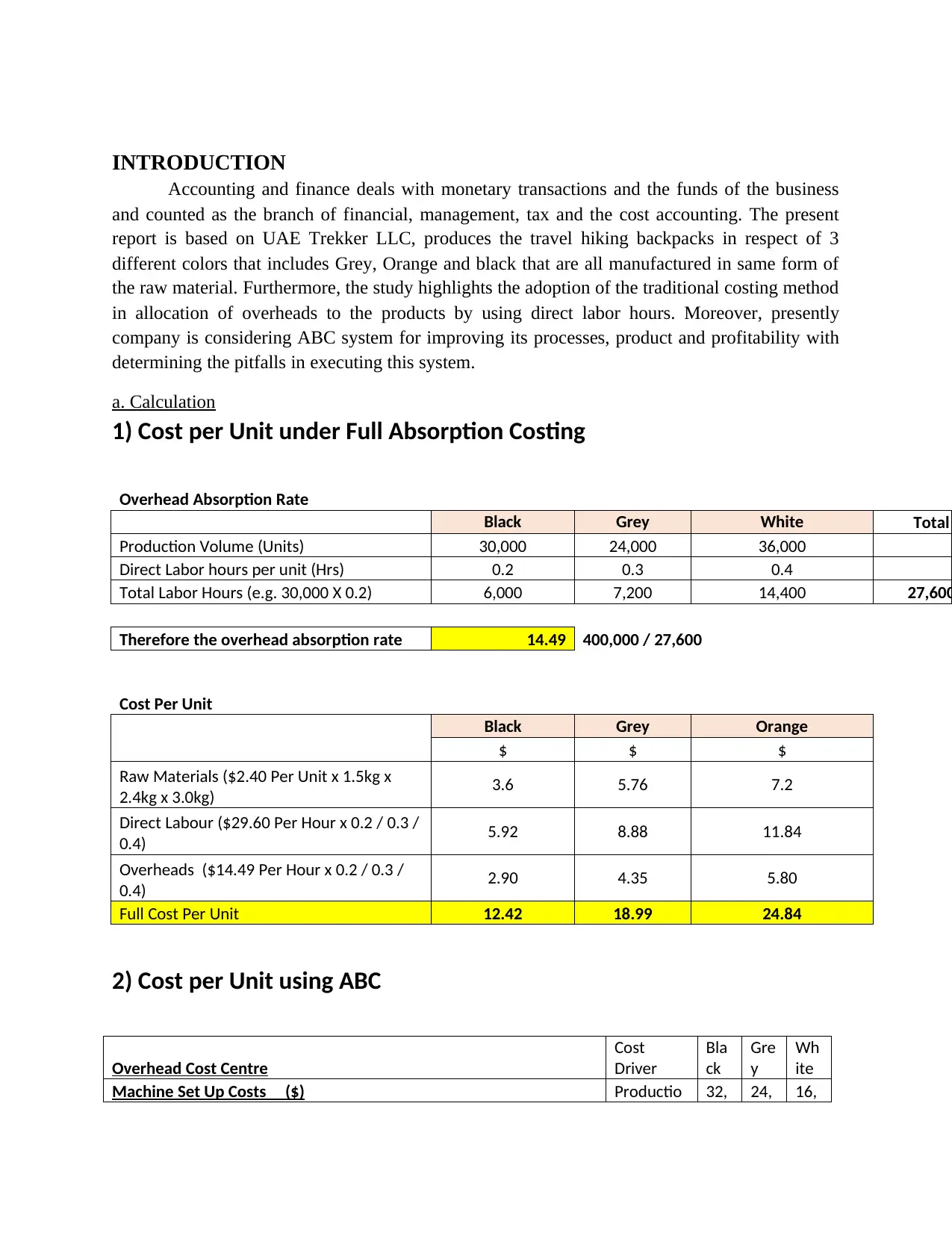
INTRODUCTION
Accounting and finance deals with monetary transactions and the funds of the business
and counted as the branch of financial, management, tax and the cost accounting. The present
report is based on UAE Trekker LLC, produces the travel hiking backpacks in respect of 3
different colors that includes Grey, Orange and black that are all manufactured in same form of
the raw material. Furthermore, the study highlights the adoption of the traditional costing method
in allocation of overheads to the products by using direct labor hours. Moreover, presently
company is considering ABC system for improving its processes, product and profitability with
determining the pitfalls in executing this system.
a. Calculation
1) Cost per Unit under Full Absorption Costing
Overhead Absorption Rate
Black Grey White Total
Production Volume (Units) 30,000 24,000 36,000
Direct Labor hours per unit (Hrs) 0.2 0.3 0.4
Total Labor Hours (e.g. 30,000 X 0.2) 6,000 7,200 14,400 27,600
Therefore the overhead absorption rate 14.49 400,000 / 27,600
Cost Per Unit
Black Grey Orange
$ $ $
Raw Materials ($2.40 Per Unit x 1.5kg x
2.4kg x 3.0kg) 3.6 5.76 7.2
Direct Labour ($29.60 Per Hour x 0.2 / 0.3 /
0.4) 5.92 8.88 11.84
Overheads ($14.49 Per Hour x 0.2 / 0.3 /
0.4) 2.90 4.35 5.80
Full Cost Per Unit 12.42 18.99 24.84
2) Cost per Unit using ABC
Overhead Cost Centre
Cost
Driver
Bla
ck
Gre
y
Wh
ite
Machine Set Up Costs ($) Productio 32, 24, 16,
Accounting and finance deals with monetary transactions and the funds of the business
and counted as the branch of financial, management, tax and the cost accounting. The present
report is based on UAE Trekker LLC, produces the travel hiking backpacks in respect of 3
different colors that includes Grey, Orange and black that are all manufactured in same form of
the raw material. Furthermore, the study highlights the adoption of the traditional costing method
in allocation of overheads to the products by using direct labor hours. Moreover, presently
company is considering ABC system for improving its processes, product and profitability with
determining the pitfalls in executing this system.
a. Calculation
1) Cost per Unit under Full Absorption Costing
Overhead Absorption Rate
Black Grey White Total
Production Volume (Units) 30,000 24,000 36,000
Direct Labor hours per unit (Hrs) 0.2 0.3 0.4
Total Labor Hours (e.g. 30,000 X 0.2) 6,000 7,200 14,400 27,600
Therefore the overhead absorption rate 14.49 400,000 / 27,600
Cost Per Unit
Black Grey Orange
$ $ $
Raw Materials ($2.40 Per Unit x 1.5kg x
2.4kg x 3.0kg) 3.6 5.76 7.2
Direct Labour ($29.60 Per Hour x 0.2 / 0.3 /
0.4) 5.92 8.88 11.84
Overheads ($14.49 Per Hour x 0.2 / 0.3 /
0.4) 2.90 4.35 5.80
Full Cost Per Unit 12.42 18.99 24.84
2) Cost per Unit using ABC
Overhead Cost Centre
Cost
Driver
Bla
ck
Gre
y
Wh
ite
Machine Set Up Costs ($) Productio 32, 24, 16,
Paraphrase This Document
Need a fresh take? Get an instant paraphrase of this document with our AI Paraphraser
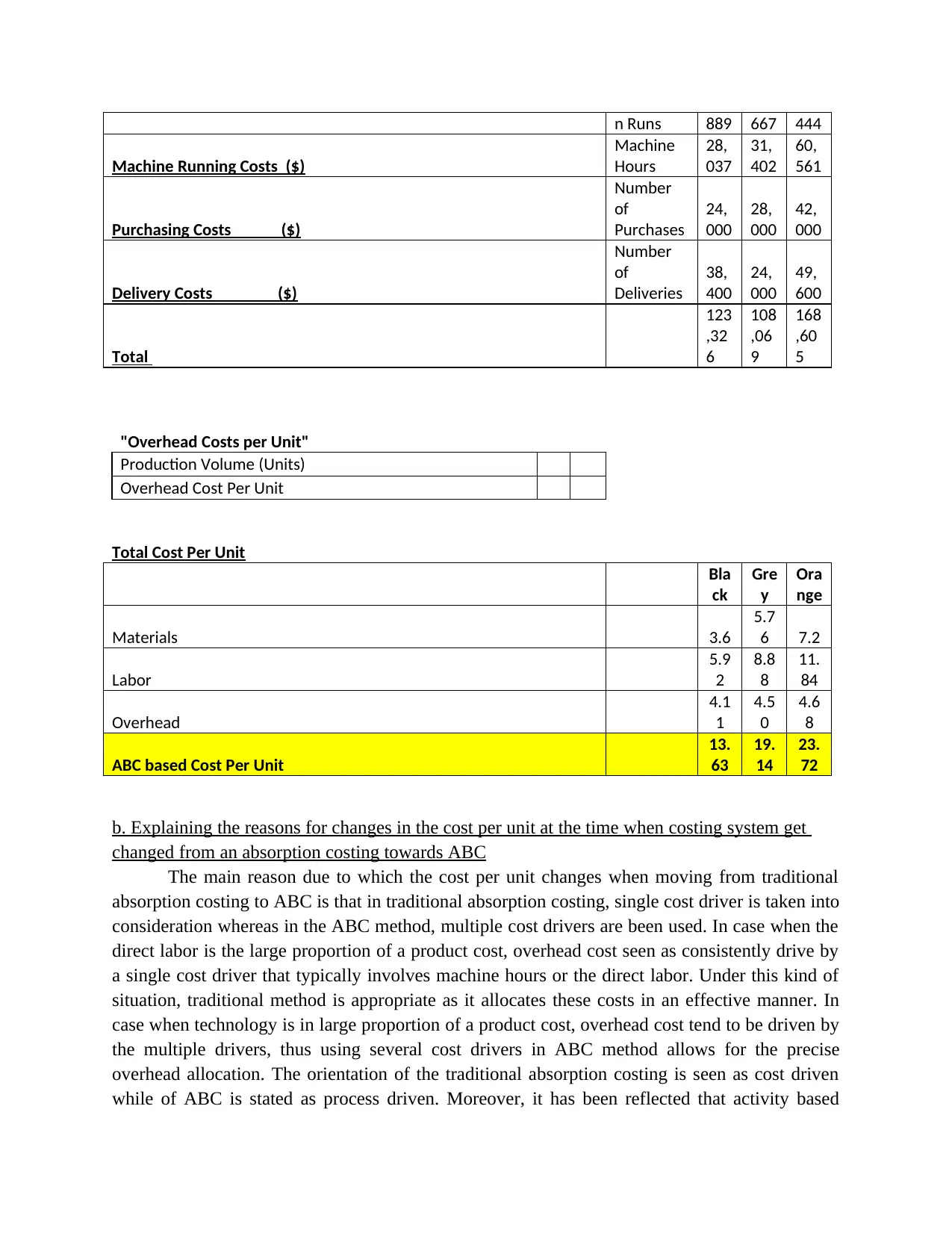
n Runs 889 667 444
Machine Running Costs ($)
Machine
Hours
28,
037
31,
402
60,
561
Purchasing Costs ($)
Number
of
Purchases
24,
000
28,
000
42,
000
Delivery Costs ($)
Number
of
Deliveries
38,
400
24,
000
49,
600
Total
123
,32
6
108
,06
9
168
,60
5
"Overhead Costs per Unit"
Production Volume (Units)
Overhead Cost Per Unit
Total Cost Per Unit
Bla
ck
Gre
y
Ora
nge
Materials 3.6
5.7
6 7.2
Labor
5.9
2
8.8
8
11.
84
Overhead
4.1
1
4.5
0
4.6
8
ABC based Cost Per Unit
13.
63
19.
14
23.
72
b. Explaining the reasons for changes in the cost per unit at the time when costing system get
changed from an absorption costing towards ABC
The main reason due to which the cost per unit changes when moving from traditional
absorption costing to ABC is that in traditional absorption costing, single cost driver is taken into
consideration whereas in the ABC method, multiple cost drivers are been used. In case when the
direct labor is the large proportion of a product cost, overhead cost seen as consistently drive by
a single cost driver that typically involves machine hours or the direct labor. Under this kind of
situation, traditional method is appropriate as it allocates these costs in an effective manner. In
case when technology is in large proportion of a product cost, overhead cost tend to be driven by
the multiple drivers, thus using several cost drivers in ABC method allows for the precise
overhead allocation. The orientation of the traditional absorption costing is seen as cost driven
while of ABC is stated as process driven. Moreover, it has been reflected that activity based
Machine Running Costs ($)
Machine
Hours
28,
037
31,
402
60,
561
Purchasing Costs ($)
Number
of
Purchases
24,
000
28,
000
42,
000
Delivery Costs ($)
Number
of
Deliveries
38,
400
24,
000
49,
600
Total
123
,32
6
108
,06
9
168
,60
5
"Overhead Costs per Unit"
Production Volume (Units)
Overhead Cost Per Unit
Total Cost Per Unit
Bla
ck
Gre
y
Ora
nge
Materials 3.6
5.7
6 7.2
Labor
5.9
2
8.8
8
11.
84
Overhead
4.1
1
4.5
0
4.6
8
ABC based Cost Per Unit
13.
63
19.
14
23.
72
b. Explaining the reasons for changes in the cost per unit at the time when costing system get
changed from an absorption costing towards ABC
The main reason due to which the cost per unit changes when moving from traditional
absorption costing to ABC is that in traditional absorption costing, single cost driver is taken into
consideration whereas in the ABC method, multiple cost drivers are been used. In case when the
direct labor is the large proportion of a product cost, overhead cost seen as consistently drive by
a single cost driver that typically involves machine hours or the direct labor. Under this kind of
situation, traditional method is appropriate as it allocates these costs in an effective manner. In
case when technology is in large proportion of a product cost, overhead cost tend to be driven by
the multiple drivers, thus using several cost drivers in ABC method allows for the precise
overhead allocation. The orientation of the traditional absorption costing is seen as cost driven
while of ABC is stated as process driven. Moreover, it has been reflected that activity based

costing is the more accurate technique as it assigns an overhead cost on the basis of activities that
drives for an overhead costs. By this it could be concluded that subsequent gross loss and the
cost for every sales unit provides for a more accurate picture or view than the entire cost and the
gross profit under a traditional absorption method.
c. Presenting implications relating to cost management for switching to ABC system
ABC brings reliability and accuracy in the determination of cost by emphasizing on the cause&
effect relationship in the occurrence of the cost. It helps in recognizing the activity that causes
costs not the products and identifies the product that consumes more and more activities. In an
advanced manufacturing and the technology where the support functions the overheads presents
larger share of a total costs, the ABC technique facilitates a more true and realistic cost of
products. As in this case three products are included so ABC is counted as the best method
because it works well with diversity in the products produced and provide a correct and the
reliable data of the product cost (Altawati and et.al., 2018). Traditional system brings
anticipations and the errors in determination of the product cost because of using an arbitrary
apportionment and the absorption technique. ABC system facilitates better costing related
information and enables the management in gaining a better insights or an understanding of
company’s competitive strength and the weaknesses. Moreover, managers recognizes
requirement for the better costing method like ABC in case they are been experiencing an
increased lost of the sales because of erroneous pricing which led from an inaccurate data of the
costing. It provides not only the base for computing the accurate cost but also provides for a
mechanism in managing the cost. It is the systems that emphasize attention of the management
on underlying causes of the costs. This system assumes that the resource-consuming activity
causes the cost and that the product which incur cost by way of activities that they are needed for
manufacturing, designing, delivery, marketing and the servicing. Through gathering and
reporting on important activities within which an organization engages, there are chances for
understanding and managing the cost effectively.
Along with an ABC system, costs are been managed in long run through controlling activities
which drives them. On the other hand, aim of this system is to manage all the activities instead of
cost. By way of managing those forces which causes an activity that is cost drivers,
automatically cost would be managed effectively in long term. Thus, Application of ABC system
might be having a greatest potential in contributing to the cost management, control, budgeting
and an evaluation of the performance.
d. Explaining an impact of switching from absorption to ABC on product & pricing profitability
ABC system has a great impact on the companies that are having large areas, higher level of
expenses, having numerous products, customers, services, processes and the combination all
these factors. For example- Plants that are producing a custom and the standard products, low
volume products and mature or new products. Corporations that are accepting the large and the
small orders offers for a customized and the standard deliveries and satisfies all the customers
involving those with frequent changes in their demand before and after a delivery and a customer
drives for an overhead costs. By this it could be concluded that subsequent gross loss and the
cost for every sales unit provides for a more accurate picture or view than the entire cost and the
gross profit under a traditional absorption method.
c. Presenting implications relating to cost management for switching to ABC system
ABC brings reliability and accuracy in the determination of cost by emphasizing on the cause&
effect relationship in the occurrence of the cost. It helps in recognizing the activity that causes
costs not the products and identifies the product that consumes more and more activities. In an
advanced manufacturing and the technology where the support functions the overheads presents
larger share of a total costs, the ABC technique facilitates a more true and realistic cost of
products. As in this case three products are included so ABC is counted as the best method
because it works well with diversity in the products produced and provide a correct and the
reliable data of the product cost (Altawati and et.al., 2018). Traditional system brings
anticipations and the errors in determination of the product cost because of using an arbitrary
apportionment and the absorption technique. ABC system facilitates better costing related
information and enables the management in gaining a better insights or an understanding of
company’s competitive strength and the weaknesses. Moreover, managers recognizes
requirement for the better costing method like ABC in case they are been experiencing an
increased lost of the sales because of erroneous pricing which led from an inaccurate data of the
costing. It provides not only the base for computing the accurate cost but also provides for a
mechanism in managing the cost. It is the systems that emphasize attention of the management
on underlying causes of the costs. This system assumes that the resource-consuming activity
causes the cost and that the product which incur cost by way of activities that they are needed for
manufacturing, designing, delivery, marketing and the servicing. Through gathering and
reporting on important activities within which an organization engages, there are chances for
understanding and managing the cost effectively.
Along with an ABC system, costs are been managed in long run through controlling activities
which drives them. On the other hand, aim of this system is to manage all the activities instead of
cost. By way of managing those forces which causes an activity that is cost drivers,
automatically cost would be managed effectively in long term. Thus, Application of ABC system
might be having a greatest potential in contributing to the cost management, control, budgeting
and an evaluation of the performance.
d. Explaining an impact of switching from absorption to ABC on product & pricing profitability
ABC system has a great impact on the companies that are having large areas, higher level of
expenses, having numerous products, customers, services, processes and the combination all
these factors. For example- Plants that are producing a custom and the standard products, low
volume products and mature or new products. Corporations that are accepting the large and the
small orders offers for a customized and the standard deliveries and satisfies all the customers
involving those with frequent changes in their demand before and after a delivery and a customer
⊘ This is a preview!⊘
Do you want full access?
Subscribe today to unlock all pages.

Trusted by 1+ million students worldwide
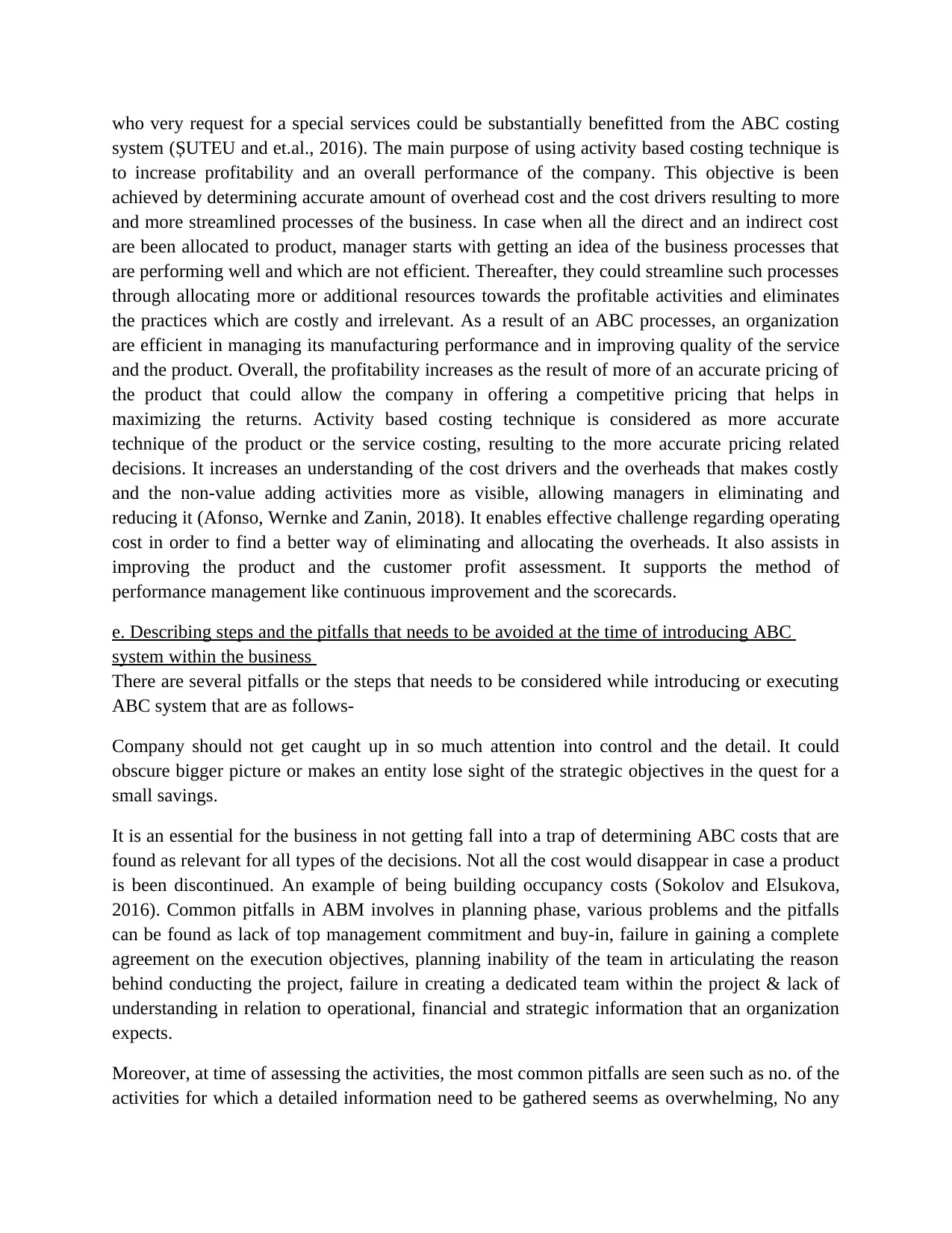
who very request for a special services could be substantially benefitted from the ABC costing
system (ȘUTEU and et.al., 2016). The main purpose of using activity based costing technique is
to increase profitability and an overall performance of the company. This objective is been
achieved by determining accurate amount of overhead cost and the cost drivers resulting to more
and more streamlined processes of the business. In case when all the direct and an indirect cost
are been allocated to product, manager starts with getting an idea of the business processes that
are performing well and which are not efficient. Thereafter, they could streamline such processes
through allocating more or additional resources towards the profitable activities and eliminates
the practices which are costly and irrelevant. As a result of an ABC processes, an organization
are efficient in managing its manufacturing performance and in improving quality of the service
and the product. Overall, the profitability increases as the result of more of an accurate pricing of
the product that could allow the company in offering a competitive pricing that helps in
maximizing the returns. Activity based costing technique is considered as more accurate
technique of the product or the service costing, resulting to the more accurate pricing related
decisions. It increases an understanding of the cost drivers and the overheads that makes costly
and the non-value adding activities more as visible, allowing managers in eliminating and
reducing it (Afonso, Wernke and Zanin, 2018). It enables effective challenge regarding operating
cost in order to find a better way of eliminating and allocating the overheads. It also assists in
improving the product and the customer profit assessment. It supports the method of
performance management like continuous improvement and the scorecards.
e. Describing steps and the pitfalls that needs to be avoided at the time of introducing ABC
system within the business
There are several pitfalls or the steps that needs to be considered while introducing or executing
ABC system that are as follows-
Company should not get caught up in so much attention into control and the detail. It could
obscure bigger picture or makes an entity lose sight of the strategic objectives in the quest for a
small savings.
It is an essential for the business in not getting fall into a trap of determining ABC costs that are
found as relevant for all types of the decisions. Not all the cost would disappear in case a product
is been discontinued. An example of being building occupancy costs (Sokolov and Elsukova,
2016). Common pitfalls in ABM involves in planning phase, various problems and the pitfalls
can be found as lack of top management commitment and buy-in, failure in gaining a complete
agreement on the execution objectives, planning inability of the team in articulating the reason
behind conducting the project, failure in creating a dedicated team within the project & lack of
understanding in relation to operational, financial and strategic information that an organization
expects.
Moreover, at time of assessing the activities, the most common pitfalls are seen such as no. of the
activities for which a detailed information need to be gathered seems as overwhelming, No any
system (ȘUTEU and et.al., 2016). The main purpose of using activity based costing technique is
to increase profitability and an overall performance of the company. This objective is been
achieved by determining accurate amount of overhead cost and the cost drivers resulting to more
and more streamlined processes of the business. In case when all the direct and an indirect cost
are been allocated to product, manager starts with getting an idea of the business processes that
are performing well and which are not efficient. Thereafter, they could streamline such processes
through allocating more or additional resources towards the profitable activities and eliminates
the practices which are costly and irrelevant. As a result of an ABC processes, an organization
are efficient in managing its manufacturing performance and in improving quality of the service
and the product. Overall, the profitability increases as the result of more of an accurate pricing of
the product that could allow the company in offering a competitive pricing that helps in
maximizing the returns. Activity based costing technique is considered as more accurate
technique of the product or the service costing, resulting to the more accurate pricing related
decisions. It increases an understanding of the cost drivers and the overheads that makes costly
and the non-value adding activities more as visible, allowing managers in eliminating and
reducing it (Afonso, Wernke and Zanin, 2018). It enables effective challenge regarding operating
cost in order to find a better way of eliminating and allocating the overheads. It also assists in
improving the product and the customer profit assessment. It supports the method of
performance management like continuous improvement and the scorecards.
e. Describing steps and the pitfalls that needs to be avoided at the time of introducing ABC
system within the business
There are several pitfalls or the steps that needs to be considered while introducing or executing
ABC system that are as follows-
Company should not get caught up in so much attention into control and the detail. It could
obscure bigger picture or makes an entity lose sight of the strategic objectives in the quest for a
small savings.
It is an essential for the business in not getting fall into a trap of determining ABC costs that are
found as relevant for all types of the decisions. Not all the cost would disappear in case a product
is been discontinued. An example of being building occupancy costs (Sokolov and Elsukova,
2016). Common pitfalls in ABM involves in planning phase, various problems and the pitfalls
can be found as lack of top management commitment and buy-in, failure in gaining a complete
agreement on the execution objectives, planning inability of the team in articulating the reason
behind conducting the project, failure in creating a dedicated team within the project & lack of
understanding in relation to operational, financial and strategic information that an organization
expects.
Moreover, at time of assessing the activities, the most common pitfalls are seen such as no. of the
activities for which a detailed information need to be gathered seems as overwhelming, No any
Paraphrase This Document
Need a fresh take? Get an instant paraphrase of this document with our AI Paraphraser

significant activity appears, resources that are dedicated to project deemed as inadequate in
supporting analysis, inadequate attention towards training for building and forming an internal
expertise and lastly, failure in communicating to the employees about the purpose behind a
project and the questions results to negative feelings and defensive kind of behavior (Santana,
Afonso, Zanin and Wernke, 2017). Thus at each phase of its process, pitfalls does exist as like in
costing the products, activities and the services it includes inaccurate cost assignment to the
activities and the cost objects, activity and the resource drivers are resulting as too high, the
activity driver does not reflects a consumption rate and the pattern of its respective activities etc.
CONCLUSION
By summing up the above report, ABC costing technique is found as better as compared
to traditional method because it helps in increasing profitability by reducing cost and in taking
effective pricing decisions. Though it includes various pitfalls but there are measures which an
entity must take for avoiding such pitfalls at the time of allocating the cost and assessing
activities.
supporting analysis, inadequate attention towards training for building and forming an internal
expertise and lastly, failure in communicating to the employees about the purpose behind a
project and the questions results to negative feelings and defensive kind of behavior (Santana,
Afonso, Zanin and Wernke, 2017). Thus at each phase of its process, pitfalls does exist as like in
costing the products, activities and the services it includes inaccurate cost assignment to the
activities and the cost objects, activity and the resource drivers are resulting as too high, the
activity driver does not reflects a consumption rate and the pattern of its respective activities etc.
CONCLUSION
By summing up the above report, ABC costing technique is found as better as compared
to traditional method because it helps in increasing profitability by reducing cost and in taking
effective pricing decisions. Though it includes various pitfalls but there are measures which an
entity must take for avoiding such pitfalls at the time of allocating the cost and assessing
activities.
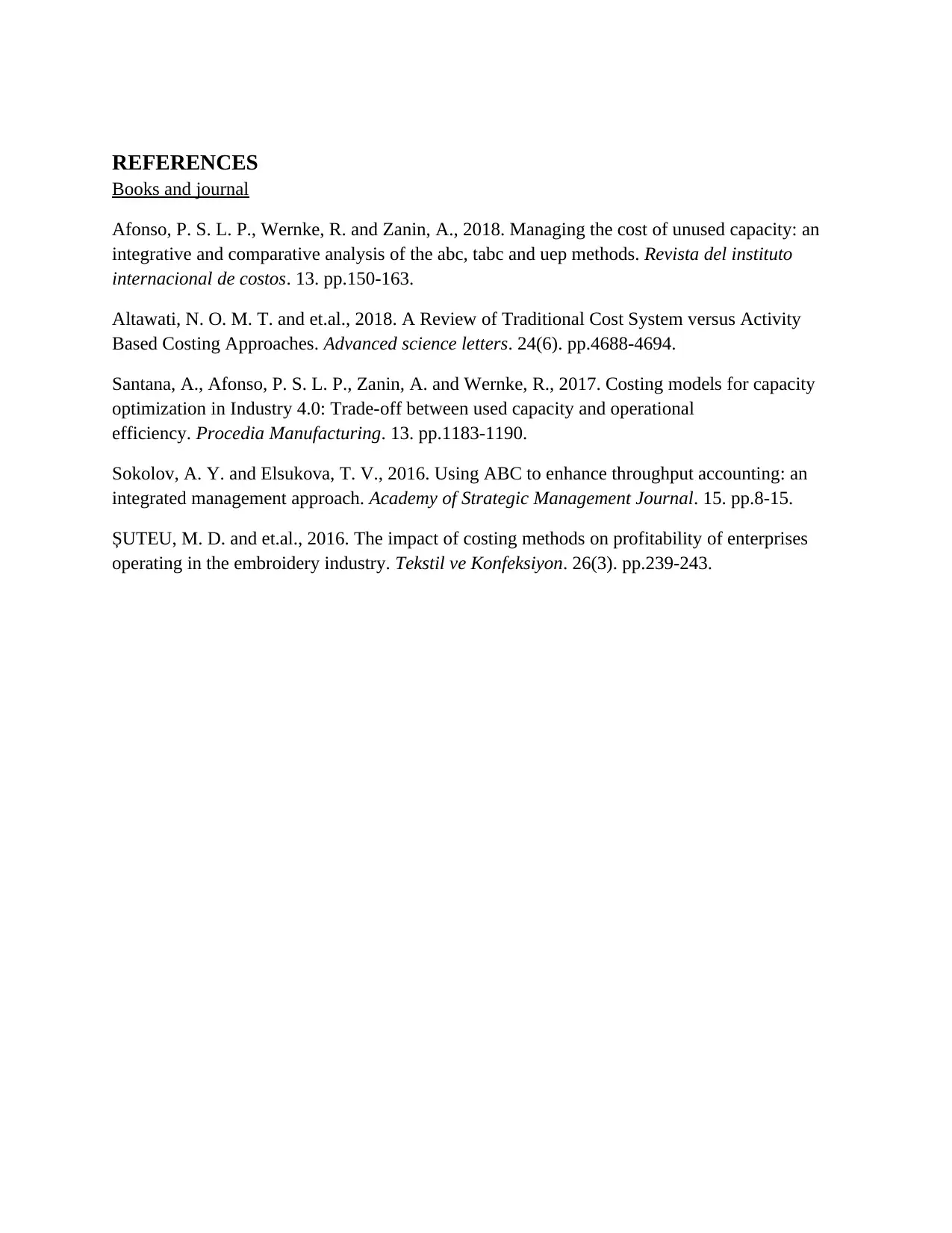
REFERENCES
Books and journal
Afonso, P. S. L. P., Wernke, R. and Zanin, A., 2018. Managing the cost of unused capacity: an
integrative and comparative analysis of the abc, tabc and uep methods. Revista del instituto
internacional de costos. 13. pp.150-163.
Altawati, N. O. M. T. and et.al., 2018. A Review of Traditional Cost System versus Activity
Based Costing Approaches. Advanced science letters. 24(6). pp.4688-4694.
Santana, A., Afonso, P. S. L. P., Zanin, A. and Wernke, R., 2017. Costing models for capacity
optimization in Industry 4.0: Trade-off between used capacity and operational
efficiency. Procedia Manufacturing. 13. pp.1183-1190.
Sokolov, A. Y. and Elsukova, T. V., 2016. Using ABC to enhance throughput accounting: an
integrated management approach. Academy of Strategic Management Journal. 15. pp.8-15.
ȘUTEU, M. D. and et.al., 2016. The impact of costing methods on profitability of enterprises
operating in the embroidery industry. Tekstil ve Konfeksiyon. 26(3). pp.239-243.
Books and journal
Afonso, P. S. L. P., Wernke, R. and Zanin, A., 2018. Managing the cost of unused capacity: an
integrative and comparative analysis of the abc, tabc and uep methods. Revista del instituto
internacional de costos. 13. pp.150-163.
Altawati, N. O. M. T. and et.al., 2018. A Review of Traditional Cost System versus Activity
Based Costing Approaches. Advanced science letters. 24(6). pp.4688-4694.
Santana, A., Afonso, P. S. L. P., Zanin, A. and Wernke, R., 2017. Costing models for capacity
optimization in Industry 4.0: Trade-off between used capacity and operational
efficiency. Procedia Manufacturing. 13. pp.1183-1190.
Sokolov, A. Y. and Elsukova, T. V., 2016. Using ABC to enhance throughput accounting: an
integrated management approach. Academy of Strategic Management Journal. 15. pp.8-15.
ȘUTEU, M. D. and et.al., 2016. The impact of costing methods on profitability of enterprises
operating in the embroidery industry. Tekstil ve Konfeksiyon. 26(3). pp.239-243.
⊘ This is a preview!⊘
Do you want full access?
Subscribe today to unlock all pages.

Trusted by 1+ million students worldwide
1 out of 9
Your All-in-One AI-Powered Toolkit for Academic Success.
+13062052269
info@desklib.com
Available 24*7 on WhatsApp / Email
![[object Object]](/_next/static/media/star-bottom.7253800d.svg)
Unlock your academic potential
Copyright © 2020–2025 A2Z Services. All Rights Reserved. Developed and managed by ZUCOL.
